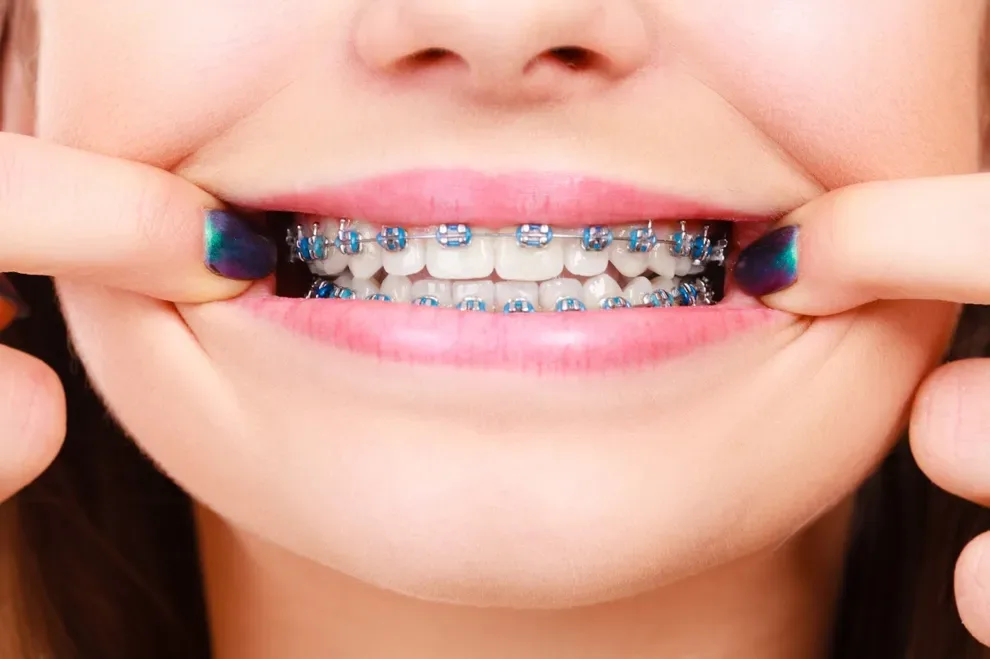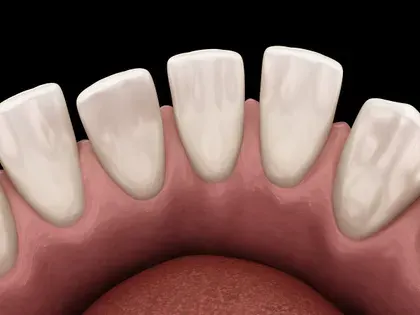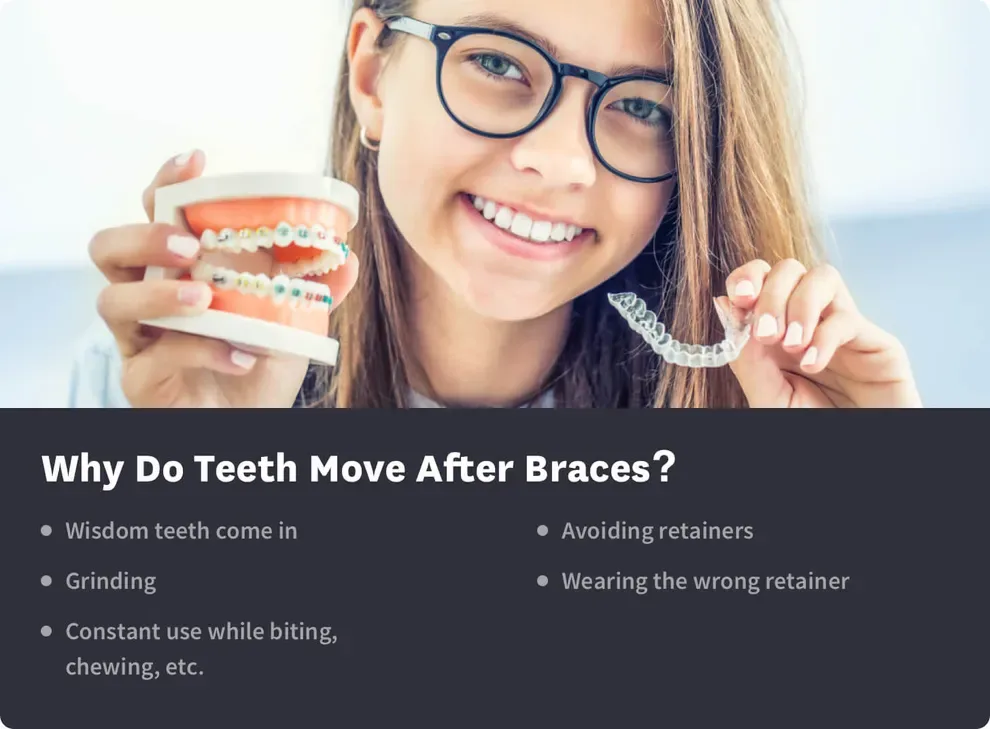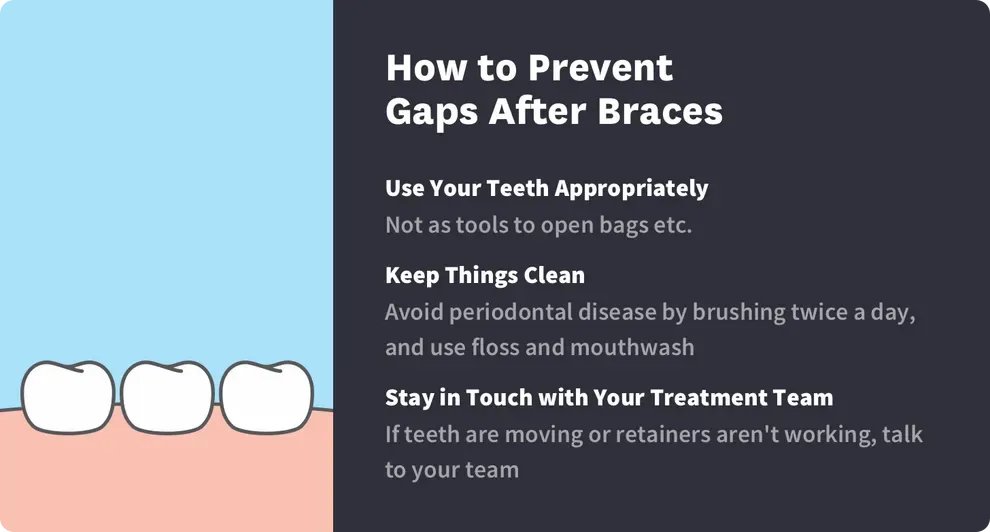Gaps After Braces: Why They Happen & What to Do

Table of Contents
- How Braces & Aligners Work
- Movement after Treatment
- Protect Your Investment
- When a Gap Forms
- Why Do Teeth Your Teeth Move?
If you’ve corrected your smile and bite with orthodontic treatment but find that your teeth have shifted and you now have gaps (or other alignment issues), it’s most likely because you haven’t worn your retainer as advised.
The retention period of orthodontic treatment begins as soon as you get your braces off or finish your last aligner tray.
A retainer is usually worn full-time for around four months to a year after treatment. After that, part-time wear is recommended indefinitely. To ensure teeth stay in place, you may wear a retainer for the rest of your life.
This is because teeth naturally shift over time, and other factors can also contribute to tooth movement. Wearing a retainer is necessary to “retain” your corrected teeth placement.
How Do Braces & Aligners Work?
Braces and aligners work by applying constant pressure to the tops of your teeth. You'll notice the shift at the crowns of your teeth, but there's a lot happening deep below the gum line.

While the speed of tooth movement can vary from person to person, most people experience a shift of about 1 mm in 4 to 5 weeks. Pressure builds on one side of the tooth, forcing the bone to break down in front of the tooth and build up behind it. The result is a tooth moving very slowly along the jawbone.
Teeth are also connected to the jaw via ligaments, which are strong, stretchy fibers. They are a lot like the tendons that hold your muscles to your bones. They should stay firmly attached, but they have a bit of flex and pull to them. These fibers stretch during orthodontic treatment, but they often take longer to fully take up their new positions.
Why Do Teeth Move After Braces or Aligners?
When your braces come off, tendons holding your teeth want to return to their original position. It's a bit like a rubber band. You can pull and pull on the tissue, and it can take on a new shape and form. But if you let go, it will try to snap back to the original shape.
Doctors call the period after treatment the retention phase. They tell their patients retainers are critical during this time frame. If you don’t wear your retainers, your teeth can take up their old positions and undo all the hard work you put in.
Researchers say that changes in tooth movement in the first 3 to 12 months after treatment are closely associated with how teeth look 10 to 12 years later. This suggests your teeth move most in the year after treatment, but your results may vary.
Your Teeth Will Move After Treatment

Once the pressure of braces or aligners is released, your teeth can and will begin to move once again. But other factors can also play a role. Teeth can also move due to these issues:
Wisdom teeth are molars that typically emerge when people are ages 17 to 25. That means some people get these teeth when their orthodontic treatment is through.
Some people develop impacted wisdom teeth that don’t have enough room to develop normally. If left untreated, these teeth could cause infections that spread to other teeth. They could shift as the infection spreads.
Plenty of people grind their teeth at night, dentists say. The damage can be subtle. You may not wake up to see tooth shavings on your pillow, but the pressure can wear down the tops of your teeth, and the clenching can cause your teeth to move.
We use our teeth for all sorts of things, including biting, grinding, and chewing. We may also use our teeth as tools if we tear open food packages. Every time we use our teeth, the pressure could cause movement.
Some of these issues can't be corrected. You can't stop yourself from talking or chewing, for example, and your wisdom teeth may appear whether you want them or not. But there are plenty of things you could do after treatment that could make your teeth move.
Your teeth are most vulnerable to shifts in the months immediately following treatment. Typically, you'll wear retainers around the clock during this critical time. Then, you might move to wearing devices only at night.
Just like any other device, your retainer can crack, break, or slip. If it doesn't fit on your teeth just right, movements are inevitable. That's why it's critical to reach out for help when it doesn't seem quite right.
In studies like this one and this one, researchers couldn’t find evidence that one retainer worked better than all the others in all mouths. However, the best retainer is one you will wear properly. For some, that means permanent retainers that never come out. For others, that means removable retainers that are comfortable and allow for proper cleaning. Retainers won't work and help your teeth unless you wear them. If you skip this step, you could see your teeth move dramatically.
Your teeth are almost always in motion and after braces or aligners are removed, gaps between your teeth can form.
How to Protect your Investment

It's clear that wearing retainers is one of the best ways to ensure that you don't develop gaps in your teeth after braces. But there are many other steps you can take to keep your smile looking its best.
Make sure gaps are minimized by doing these things:
If you use your teeth like tools, it's time to stop. Reach for scissors to open up bags and containers, and don't chew on inanimate objects like pencils and pens.
Advanced periodontal disease can make your gums swell or recede, and that can lead to even more gapping and movement. Brush twice per day, every single day, and use floss and mouthwash too. A water flosser can also help.
If you feel your teeth are moving or if you notice that your retainers don't work to protect your teeth, point that out to your team. Close contact is the best way to ensure you get timely help. They may need to create a new retainer for you.
Despite all of these steps, your teeth may still move a bit. But by putting your dental health first, you could minimize the gaps.
What Happens when a Gap Forms?
You've followed all the steps, and you still have a gap in your teeth. Your dental team may be able to help. Some aligner companies offer guarantees. If you followed treatment instructions but still developed gaps, you may be able to get another round of treatment at no cost.
Orthodontists may not offer the same protections, but it's worthwhile to ask if problems appear.If not, you could consider another form of treatment. If you used braces the first time, teeth aligners could be a good choice for dental corrections after treatment ends. If gaps are very small, your doctor may use modified retainers to push your teeth back into place. But if the gaps are bigger, you may need another round of treatment with aligners or braces to ensure that your teeth move back into position.
